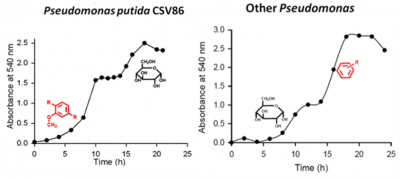
Aromatic compounds are most extensively used in various industries like plastic, paint, pesticide, petrochemical etc. These compounds are released into the environment due to various natural and anthropogenic activities leading to pollution. Biodegradation is a viable way to remove these pollutants to harmless metabolites. Multiple factors play an important role in efficient Multiple factors play an important role in efficient bioremediation of pollutants by microorganisms viz. concentration, solubility and complexity, production of biosurfactant, sustainable microbial biomass production and carbon catabolite repression.
seudomonas putida CSV86, isolated from soil by enrichment culture technique shows an excellent aromatic compound Glucose degradation property. It has an ability to degrade naphthalene, methylnaphthalene, phenylacetic acid, p-hydroxyphenylacetic acid, benzoate, p-hydroxybenzoate, phenylpropanoids, etc. Interestingly, strain CSV86 preferentially utilises aromatics over glucose and co-metabolises organic acid and aromatic compounds. This
property is unique compared to other Pseudomonas studied so far where hierarchy of the carbon source utilisation is organic acid > glucose > aromatic.
The strain CSV86 lacks the low affinity pathway for glucose transport present in other pseudomonads allowing glucose to enter only through the ATP dependent ABC transporter. This transport system comprises of a periplasmic glucose binding protein GBP, outer membrane porin OprB, two inner membrane ABC transporter proteins GlcF and GlcG and a membrane bound cytoplasmic ATPase, GlcK. The periplasmic glucose binding protein confers specificity to the system. The crystal structure of this
protein has been solved with 1.7 Å resolution . The property of preferential utilisation of aromatics over glucose is conferred due to repression of glucose transport (GBP periplasmic glucose binding protein, OprB glucose selective outer membrane protein) and metabolism (Zwf) by aromatics and organic acids.
Draft genome sequence of strain CSV86 reveals the presence of genes involved in the catabolic pathways of other aromatic compounds and heavy metal resistance. As strain CSV86 has ability to preferentially utilise aromatics (globally) over simple carbon source like glucose, it increases the potential for its use in biodegradation and biorefinery. Moreover this strain also serves as efficient genetic tool for studying metabolic engineering, so as to construct a robust strain for efficient removal of aromatic pollutants from contaminated environment
Prof. P S Phale
